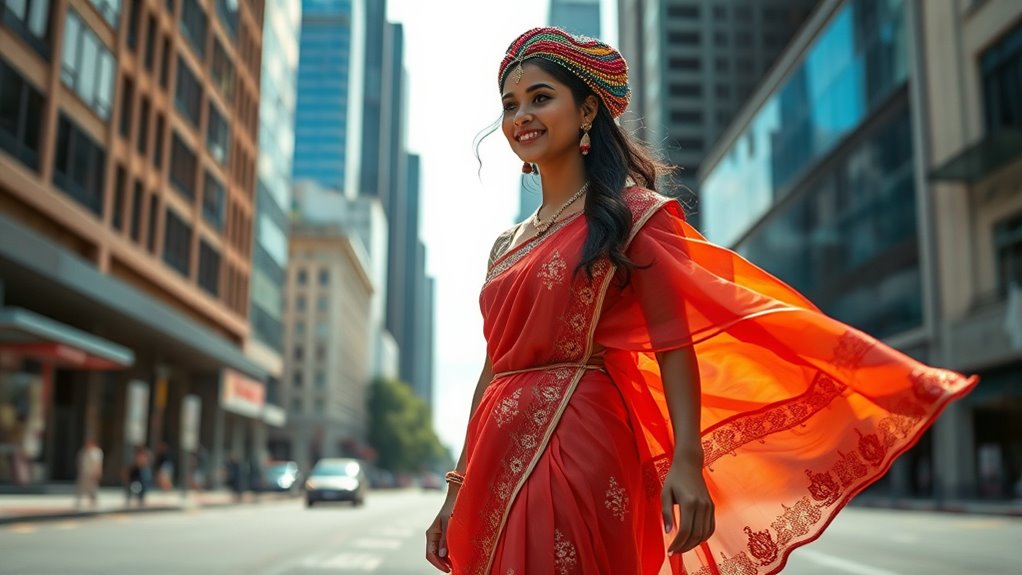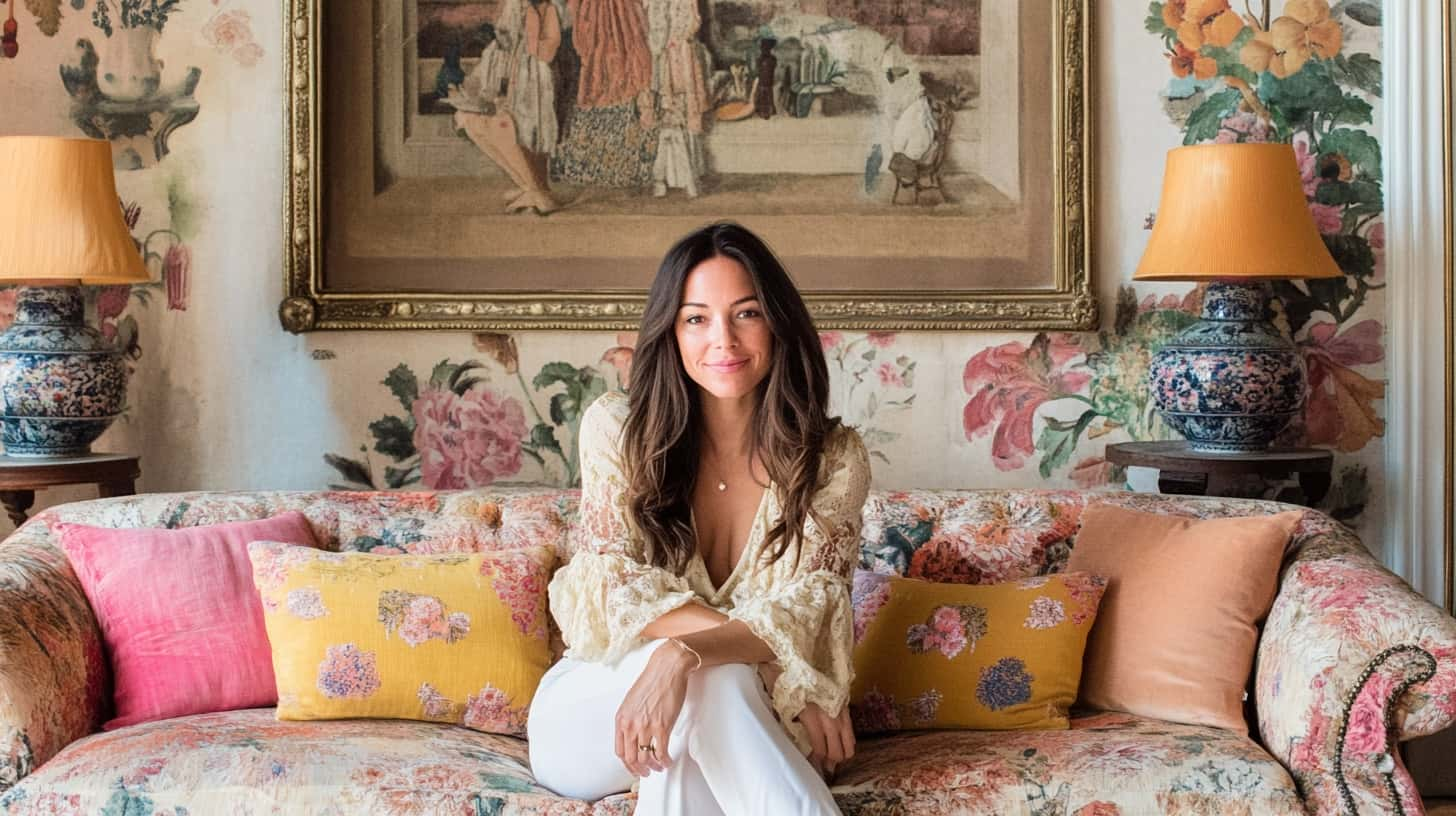To incorporate cultural attire into modern fashion, start by pairing traditional pieces with contemporary items like jeans or tailored jackets for a balanced look. Add subtle accessories, such as jewelry or scarves featuring cultural motifs, and consider layering to add versatility. Use neutral footwear to let the intricate designs stand out. Respect and understand the cultural significance behind each piece, and if you keep exploring, you’ll discover how to blend heritage with style thoughtfully and authentically.
Key Takeaways
- Respectfully research and understand the cultural significance behind traditional attire before integrating it into modern fashion.
- Collaborate with artisans and cultural representatives to ensure authentic and respectful incorporation of traditional elements.
- Pair cultural garments with contemporary pieces like jeans or tailored jackets for a balanced, modern look.
- Use minimal accessories and neutral footwear to highlight the cultural attire without overwhelming the outfit.
- Promote awareness of cultural symbolism and heritage, fostering appreciation and responsible representation in fashion.
Exploring the Rich Heritage of Traditional Textiles
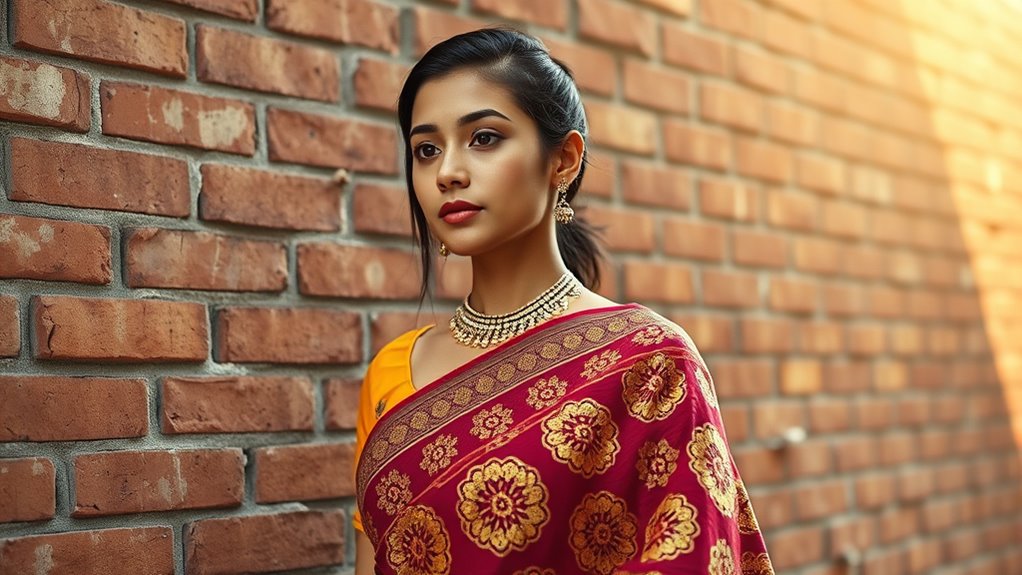
Have you ever wondered how traditional textiles reflect a community’s history and identity? When you look at these fabrics, you’re seeing more than just patterns and colors—you’re witnessing stories passed down through generations. Each stitch, motif, and dye has cultural significance, representing beliefs, social status, or historical events. For example, certain weaves might symbolize unity or protection, while specific colors convey emotions or spiritual meanings. These textiles often involve techniques unique to their region, showcasing craftsmanship and local resources. By exploring traditional textiles, you connect with the community’s origins and values. They serve as living artifacts, preserving heritage amid changing times. Recognizing this richness helps you appreciate the deep roots behind the fabrics you wear or admire. Additionally, understanding textile symbolism enhances your appreciation of the stories woven into each piece, fostering a deeper respect for cultural heritage and the artisans who create these meaningful works. The unique firing techniques used in Hopi pottery also reflect a deep spiritual connection and adaptation to their environment, further illustrating how craftsmanship embodies cultural identity. Exploring the craftsmanship involved reveals the meticulous skill passed down through generations, highlighting the importance of preserving traditional methods.
Modern Styling Tips for Cultural Garments
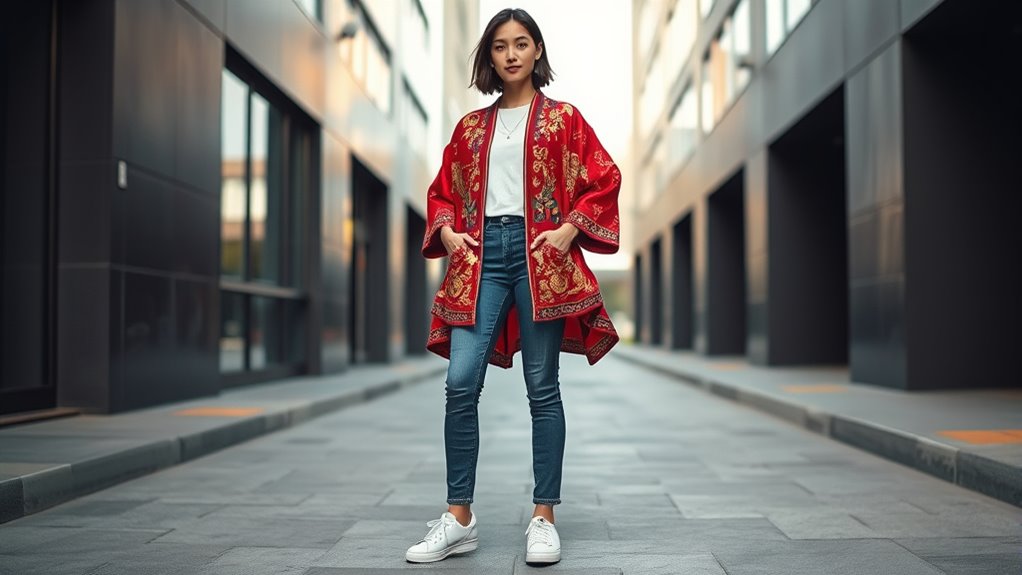
To seamlessly incorporate cultural garments into modern fashion, focus on pairing them with contemporary pieces to create balanced, stylish looks. Mix traditional and modern elements by combining a vibrant sari with sleek jeans or a classic dashiki with tailored trousers. Keep accessories minimal to let the garment stand out, and choose neutral footwear for versatility. Layering is also effective—try a cultural shawl over a simple top or a statement necklace with a traditional dress. Here’s a quick guide:
| Style Tip | Example | Key Focus |
|---|---|---|
| Pair with jeans | Embroidered blouse + denim jeans | Casual, trendy look |
| Minimal accessories | Traditional dress + simple jewelry | Let the attire shine |
| Mix textures | Silk + leather accents | Adds depth and interest |
| Layering | Shawl over modern top | Versatility and dimension |
| Neutral footwear | Sandals or sneakers | Balance colorful garments |
This approach helps you celebrate heritage while staying stylish. Additionally, incorporating innovative fabric techniques can elevate traditional attire into contemporary fashion statements. Moreover, understanding the cultural significance behind garments can enhance respect and authenticity in your styling choices. Recognizing the importance of cultural adaptability allows for more creative and respectful fusion of styles, fostering appreciation and awareness of different traditions. Exploring modern fashion trends can also provide inspiration for integrating cultural elements seamlessly into everyday wear.
Celebrating Diversity Through Fashion Statements

By incorporating cultural attire into your wardrobe, you already take a step toward celebrating heritage and individuality. Fashion becomes a powerful tool to showcase diversity and foster understanding. When you wear pieces inspired by different cultures, you send a message of respect and appreciation. It’s about more than just style; it’s a statement that highlights the richness of global traditions. You can spark conversations and challenge stereotypes by confidently embracing your cultural roots or exploring others’. Wearing diverse fashion choices demonstrates that beauty and identity come in many forms. Through your wardrobe, you become an ambassador for inclusion, encouraging others to appreciate and celebrate differences. Incorporating cultural attire into your style can also introduce you to unique fabrics and craftsmanship that enrich your fashion experience. Embracing cultural diversity in fashion helps break down barriers and promotes a more inclusive outlook. Understanding the cultural impact of technology can further deepen your appreciation for how traditional garments influence modern fashion trends. Ultimately, your fashion statements help create a more open, understanding world where diversity is recognized and honored.
Key Pieces to Incorporate Cultural Elements
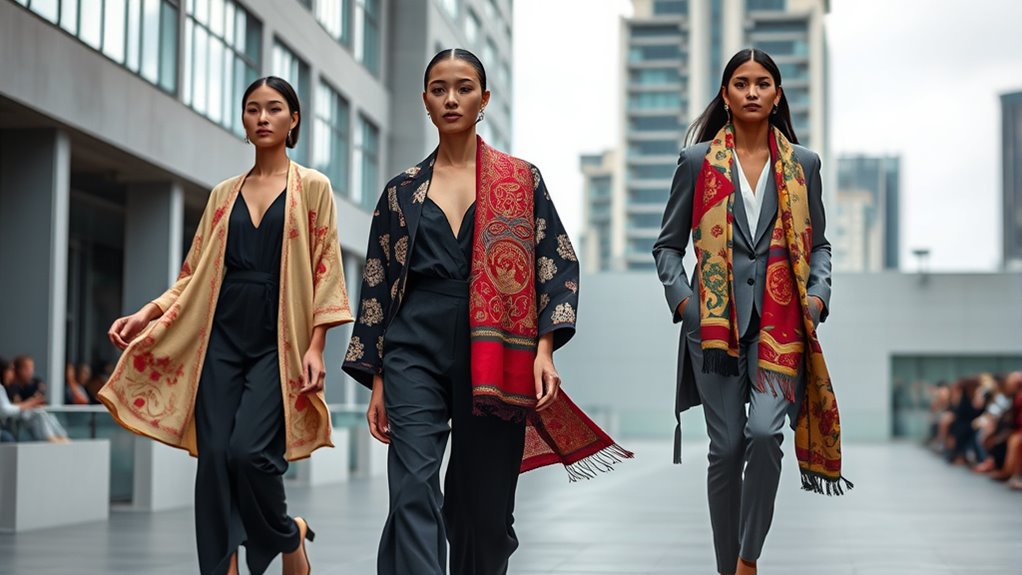
Incorporating cultural elements into your wardrobe can be both meaningful and stylish when you choose key pieces that honor tradition while fitting seamlessly into modern fashion. Start with accessories like statement jewelry, scarves, or belts featuring traditional patterns or motifs. These small touches add authenticity without overwhelming your outfit. Incorporate embroidered or printed garments, such as blouses, skirts, or tunics, that highlight cultural craftsmanship. Footwear, like embroidered sandals or loafers, can also make a subtle statement. Consider fabrics like silk, brocade, or woven textiles that carry cultural significance. When selecting these pieces, prioritize quality and authenticity to genuinely celebrate the culture. Balancing these elements with contemporary styles allows you to create a look that respects tradition while remaining fashionable. Additionally, understanding cultural attire trends can help you stay updated on modern ways to integrate traditional fashion into everyday wear.
Navigating Cultural Appreciation and Appropriation

Using cultural attire thoughtfully involves more than just selecting beautiful pieces; it requires understanding the difference between appreciation and appropriation. Appreciation celebrates the culture’s significance and involves respectful engagement, while appropriation often disrespects origins and commodifies traditions. To navigate this, research the history and meaning behind the attire, and seek permission or guidance from cultural insiders when possible. Be mindful of context—wear pieces in appropriate settings, avoiding stereotypes or trivialization. Here’s a quick guide:
| Appreciation | Appropriation |
|---|---|
| Respectful understanding | Ignoring cultural significance |
| Learning history | Using attire as costume |
| Supporting artisans | Commercializing traditions |
| Giving credit | Taking without acknowledgment |
| Engaging genuinely | Cultural insensitivity |
Additionally, understanding the Relationships – Personality Test can help in assessing personal motivations and ensuring respectful cultural engagement. It’s also important to be aware of cultural sensitivity to avoid unintentional offense or misrepresentation. Being aware of cultural significance can further guide respectful choices and deepen understanding. Developing cultural intelligence can support ongoing efforts to engage authentically and responsibly with diverse traditions. Recognizing creative practice as an ongoing process can help in cultivating a more mindful and respectful approach to incorporating cultural elements into fashion.
Frequently Asked Questions
How Can I Sustainably Source Authentic Cultural Garments?
You can sustainably source authentic cultural garments by researching reputable artisans and cooperatives committed to fair trade practices. Visit local markets or online platforms that prioritize ethical sourcing and transparency. Support small-scale producers who preserve traditional techniques, avoid mass-produced items, and guarantee fair wages. By doing so, you’re respecting the cultural significance of the attire while promoting sustainable fashion practices that benefit communities and protect cultural heritage.
What Are the Best Occasions to Wear Traditional Attire Today?
You can wear traditional attire to celebrate cultural festivals, weddings, or special ceremonies, where it honors your heritage and adds authenticity. Additionally, consider wearing it during cultural events, art shows, or community gatherings to showcase your roots proudly. Even casual outings or photoshoots are great opportunities to blend tradition with modern style. Just guarantee you’re respectful and mindful of the significance behind the attire, making each occasion meaningful.
How Do Cultural Garments Influence Global Fashion Trends?
Cultural garments heavily influence global fashion trends by inspiring designers to blend traditional elements with contemporary styles. You might notice vibrant patterns, unique textiles, and distinctive accessories appearing on runways, streetwear, or casual wear worldwide. This fusion promotes diversity and authenticity, encouraging you to embrace cultural diversity in your wardrobe. As a result, traditional attire becomes a source of innovation, helping shape modern fashion choices across different cultures and markets.
Are There Specific Styling Rules for Blending Cultures in Fashion?
Imagine weaving a vibrant tapestry where each thread represents a culture. When blending styles, you should respect each tradition’s core, like respecting individual threads. Use complementary colors and patterns thoughtfully, avoiding stereotypes or appropriation. It’s about creating harmony, not confusion. Approach mixing cultural attire with curiosity and sensitivity, ensuring it celebrates diversity rather than dilutes it. Your goal is to craft a unified, respectful masterpiece that honors every thread.
How Can Brands Respectfully Collaborate With Indigenous Artisans?
You can respectfully collaborate with indigenous artisans by engaging in transparent, fair partnerships that honor their craftsmanship and cultural significance. Always seek permission, give credit, and pay fair wages. Educate yourself on their traditions to avoid cultural appropriation. Building long-term relationships shows genuine respect, and involving artisans in design decisions empowers communities. Your goal should be to celebrate their artistry while supporting their livelihoods responsibly.
Conclusion
So, here you are, blending tradition with trend—an act that’s somehow both revolutionary and timeless. You embrace cultural attire, turning heads and sparking conversations, all while maybe just trying to stay stylish. Funny thing is, in a world obsessed with authenticity, you’re proving that fashion’s real power lies in respecting origins—even if you’re just wearing it to brunch. Who knew that honoring heritage could be your boldest, most fashionable statement yet?
